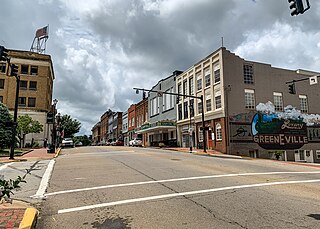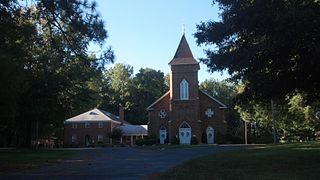
Greene County is a county located on the eastern border of the U.S. state of Tennessee. As of the 2020 census, the population was 70,152. Its county seat is Greeneville. Greene County comprises the Greeneville, TN Micropolitan Statistical Area.

Greeneville is a town in and the county seat of Greene County, Tennessee, United States. The population as of the 2020 census was 15,479. The town was named in honor of Revolutionary War hero Nathanael Greene, and it is the second oldest town in Tennessee. It is the only town with this spelling in the United States, although there are numerous U.S. towns named Greenville. The town was the capital of the short-lived State of Franklin in the 18th-century history of East Tennessee.

East Liberty Presbyterian Church, sometimes referred to as the Cathedral of Hope, is in the East Liberty neighborhood of the East End of Pittsburgh, Pennsylvania, United States. The current building is the fifth church building to occupy the site; the first was in 1819.

The Cumberland Presbyterian Church is a Presbyterian denomination spawned by the Second Great Awakening. In 2019, it had 65,087 members and 673 congregations, of which 51 were located outside of the United States. The word Cumberland comes from the Cumberland River valley where the church was founded.

Casavant Frères is a Canadian organ building company in Saint-Hyacinthe, Quebec, which has been building pipe organs since 1879. As of 2014, the company has produced more than 3,900 organs.

Tusculum University is a private Presbyterian university with its main campus in Tusculum, Tennessee, United States. It is Tennessee's first university and the 28th-oldest operating college or university in the United States.
New Bethel Presbyterian Church is the oldest Presbyterian congregation in Tennessee, according to church historian Maynard Pittendreigh, who authored a book about the congregation. It is located in the Tri-Cities area of Tennessee, in the tiny hamlet of Piney Flats.
Samuel Doak (1749–1830) was an American Presbyterian clergyman, Calvinist educator, and a former slave owner in the early movement in the United States for the abolition of slavery.

Washington College Academy was a private Presbyterian-affiliated educational institution located in Washington College, Limestone, Tennessee. Founded in 1780 by Doctor of Divinity Samuel Doak, the academy for many years offered accredited college, junior college and college preparatory instruction to day and boarding students, but financial difficulties in the 2000s forced the school to restructure its offerings and focus instead on continuing education courses for adults.
Cumberland Presbyterian Church may refer to:
Septimus Tustin was a Presbyterian clergyman who served as Chaplain of the United States House of Representatives in 1837 and as Chaplain of the United States Senate 1841–1846.

The First Presbyterian Church of Aurora, Indiana is a historic Presbyterian congregation and church located at Aurora, Dearborn County, Indiana. The original building completed in 1855 is still used, and is believed to have been designed by architect John R. Hamilton. It is a two-story, rectangular, Greek Revival style red brick building painted white. It measure approximately 45 feet wide by 75 feet deep and rests on a rough cut limestone foundation. It features a steeply tower consisting of a base, belfry, clock, and steeple.

First Presbyterian Church is located in central Davenport, Iowa, United States. It was listed on the National Register of Historic Places in 1983. The congregation is associated with the Presbyterian Church (USA).

The Fourth Presbyterian Church of Chicago is one of the largest congregations of the Presbyterian Church (U.S.A.), located in the Magnificent Mile neighborhood of Chicago, directly across Michigan Avenue from the John Hancock Center.

Thyatira Presbyterian Church, Cemetery, and Manse is a historic church at 220 White Road off NC 150 in Mill Bridge in Rowan County, North Carolina, ten miles west of the town of Salisbury. Presbyterians have been worshiping at this site since at least 1753.

Bethel Presbyterian Church is a historic Presbyterian church near Clover, South Carolina.

New Bethel Cumberland Presbyterian Church is a historic church building near Greeneville in rural Greene County, Tennessee, United States.

New Providence Presbyterian Church is a historic church in Surgoinsville, Tennessee, United States, affiliated with Presbyterian Church (USA).
Hezekiah Balch, D.D. (1741–1810) was a Presbyterian minister and the founder of Greeneville College in 1794. After the Civil War, Greeneville College merged with what is now Tusculum University.

















